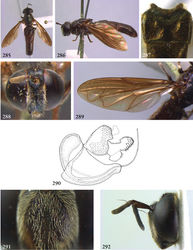Parocyptamus
| Notice: | This page is derived from the original publication listed below, whose author(s) should always be credited. Further contributors may edit and improve the content of this page and, consequently, need to be credited as well (see page history). Any assessment of factual correctness requires a careful review of the original article as well as of subsequent contributions.
If you are uncertain whether your planned contribution is correct or not, we suggest that you use the associated discussion page instead of editing the page directly. This page should be cited as follows (rationale):
Citation formats to copy and paste
BibTeX: @article{Reemer2013ZooKeys288, RIS/ Endnote: TY - JOUR Wikipedia/ Citizendium: <ref name="Reemer2013ZooKeys288">{{Citation See also the citation download page at the journal. |
Ordo: Diptera
Familia: Syrphidae
Name
Parocyptamus Shiraki – Wikispecies link – Pensoft Profile
- Parocyptamus Shiraki, 1930: 11. Type species: Parocyptamus sonamii Shiraki, 1930: 12, by original designation.
- Stenomicrodon Hull, 1937a: 26. Type species: Stenomicrodon purpureus Hull, 1937: 26, by original designation. See Hull (1949)[1] for synonymy.
Description
Body length: 11–15 mm. Slender flies with elongate, tapering abdomen and long antennae, black with metallic hues, wings infuscated. Head about as wide as thorax. Face approximately straight in profile, except for slight bulge below antenna; narrower than eye. Lateral oral margins strongly produced. Vertex flat. Occiput ventrally narrow, dorsally slightly widened. Antennal fossa about as wide as high. Eye bare. Eye margins in male parallel, not converging at level of frons, mutual distance about three times width of antennal fossa. Antennal fossa about as wide as high. Antenna longer than distance between antennal fossa and anterior oral margin. Basoflagellomere shorter than scape; oval; bare. Postpronotum pilose. Scutellum semicircular; without calcars. Anepisternum deeply sulcate; almost entirely pilose, except bare on small part ventrally. Anepimeron entirely pilose. Katepimeron convex; bare. Wing: vein R4+5 with posterior appendix; vein M1 perpendicular to vein R4+5; postero-apical corner of cell r4+5 widely rounded; crossvein r-m located around basal 1/6 of cell dm. Abdomen elongate, more than 3 times as long as wide; in male gradually tapering from anterior half of tergite 2 to apex; in female slightly constricted between tergites 3 and 4. Tergites 3 and 4 fused. Male genitalia: phallus furcate basally, with dorsal process much longer than ventral one, projecting far beyond apex of hypandrium; epandrium with ventrolateral ridge; surstylus weakly furcate, divided into two short lobes.
Diagnosis. Vein R4+5 with posterior appendix. Postpronotum pilose. Anepisternum almost entirely pilose, except bare on small ventral part. Basoflagellomere shorter than scape. Abdomen at least three times as long as wide. Tergite 2 with pair of depressed areas (Fig. 287).
Discussion
When Shiraki (1930)[2] described Parocyptamus, this genus was diagnosed in a key by the following two characters: abdomen narrow and elongate, frons with antennal prominence (‘Fühlervorsprung’). The latter character is of limited use, as the frons is more or less extended above the antennae in many other taxa of Microdontinae. Hull (1937a)[3] did not state which characters he considered diagnostic in his description of Stenomicrodon. Judging from his remarks in Hull (1949)[1], the shape of the abdomen and the presence of a patch of short, spinose setae at the base of the front and mid femora were considered important characters. Although the anterobasal patches of setae are well-developed, such patches are also found in several other taxa of Microdontinae. Perhaps the spines are somewhat stronger developed than in most taxa, but it is hard to describe this as a discrete character state. Therefore, this character is not used in the present key and Diagnosis.
The abdomen is constricted (slightly) only in the female, not in the male, as might be erroneously concluded from the key of Cheng and Thompson (2008)[4].
The synonymy of Stenomicrodon with Parocyptamus was already established by Hull (1949)[1]. Examination of the involved type specimens by the first author has confirmed this (subjective) synonymy. The type species of both genus group names are here also considered as synonyms (Parocyptamus sonamii Shiraki, 1930 = Stenomicrodon purpureus Hull, 1937 syn. n.). Microdon stenogaster Curran, 1931 also belongs to this genus, as it is almost identical to the type species in colouration, external morphology and male genitalia. Closer examination of available specimens, also from Sumatra and Thailand, is necessary to resolve species level taxonomy.
Shiraki (1930)[2] based his description of Parocyptamus sonamii on three males. Two of these syntypes are kept in the NIAS collection. The third male (from Sokotsu) is apparently lost. Label information is as follows. Syntype 1: label 1: “Formosa, Shinchiku, -18. VII 1-30. J. Sonan, K. Miyake”; label 2: “Parocyptamus sonamii”; label 3 (round, red-bordered): “Type”. Syntype 2: label 1: “CIHpOn, 17.VII.1922, M. Yoshino”; label 2 (round, red-bordered): “Type”. The date on the label of syntype 1 is a bit cryptic (“-18. VII 1-30”). It is unlikely to assume the specimen has been collected in July 1930, because Shiraki’s work was published on the 30th of January 1930. It seems more plausible that the date was 1-30 July 1918. Shiraki (1930)[2] only mentions the month (VII).
Diversity and distribution
Described species: 2. Oriental: known from Taiwan, Thailand, Sumatra and Borneo.
Taxon Treatment
- Reemer, M; Ståhls, G; 2013: Generic revision and species classification of the Microdontinae (Diptera, Syrphidae) ZooKeys, 288: 1-213. doi
Other References
- ↑ 1.0 1.1 1.2 Hull F (1949) The morphology and inter-relationships of the genera of syrphid flies, recent and fossil. Transactions of the Zoological Society 26: 257-408. doi: 10.1111/j.1096-3642.1949.tb00224.x
- ↑ 2.0 2.1 2.2 Shiraki T (1930) Die Syrphiden des Japanischen Kaiserreichs, mit berücksichtigung benachbarter Gebiete. Memoirs of the Faculty of Science and Agriculture, Taihoku Imperial University 1: 1-446.
- ↑ Hull F (1937a) New species of exotic syrphid flies. Psyche 44: 12-32. doi: 10.1155/1937/46960
- ↑ Cheng X, Thompson F (2008) A generic conspectus of the Microdontinae (Diptera: Syrphidae) with the description of two new genera from Africa and China. Zootaxa 1879: 21-48.
Images
|
